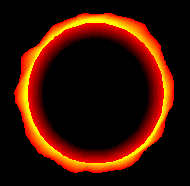|

Sun
 |
Did you know that the Sun is actually a star? The Sun is the closest star to Earth and is about 149.6 million kilometers away. It is a huge bright sphere of mostly ionised gas and is the largest object in the solar system; it is big enough to hold over a million Earths! |
| Without the Sun, the Earth would be a dark and cold place incapable of supporting human life. |
 |
 |
The Sun provides the Earth with many things like heat, light, food, and even the air we breathe! A process called photosynthesis occurring when green plants use the Sun's rays to turn carbon dioxide and water into carbohydrates, releasing the oxygen that we need to breathe in order to survive. Therefore, life on Earth, as we know it would not exist without the Sun. |
Parts of the Sun
| The Sun, in some ways, is like the Earth. Just as the Earth has a centre so does the Sun. The centre of the Sun is called the core and is made of about 75% hydrogen and 25% helium. This part of the Sun can be compared to a huge furnace, which stays lit by converting hydrogen into helium. When hydrogen atoms are fused together to form one helium atom, a tremendous amount of energy is released. The energy is so great that the Sun gives off 40,000 watts of light from every square inch of its surface! Imagine, fitting 400 kitchen lights (100 watts each) in this little square! |
 |
 |
Just like Earth, the Sun also has a lower and upper atmosphere. The photosphere is the Sun's lower atmosphere. It is a region about 500-km thick from which most of the Sun’s radiation and light escape. The photosphere is what we can see from Earth. But, remember that it is dangerous to look directly at the Sun even with sunglasses. |
| Above the photosphere is the chromosphere, which can be compared to the Earth’s upper atmosphere. The chromosphere is seen only during solar eclipses when the Moon passes in front of the Sun. The chromosphere looks like a reddish rim and is caused by hot hydrogen atoms that surround the Sun. |
 |
Finally, the outermost layer of the Sun is called the corona. It is a million times fainter than the photosphere and extends millions of kilometres into space, all the way to Pluto!
|
